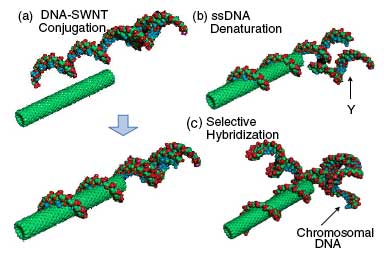| Posted: Jul 18, 2006 | |
Building optical molecular probes with nanotubes |
|
| (Nanowerk Spotlight) Researchers in South Korea used single-walled carbon nanotubes (SWNTs) to tag single-stranded DNA to locate a particular sequence of DNA within a complex genome. The results show that SWNTs may be used as generic nano-biomarkers for the precise detection of specific kinds of genes. | |
| Organic fluorophores have been widely used to tag bio-molecules in bio-imaging technologies. However, these fluorophores have several limitations, such as photobleaching, that restrict their utility in applications such as cell proliferation, stem-cell differentiation, and realtime microscopy experiments lasting several hours. Photobleaching of the chromophore limits the ability of investigators to observe their specimens repeatedly and over long periods. | |
| The strong Raman signals and fluorescence emissions emitted from SWNTs do not blink or photobleach under prolonged excitation, which is an advantage in optical nano-biomarker applications. | |
| In a recent paper, titled "The DNA hybridization assay using single-walled carbon nanotubes as ultrasensitive, long-term optical labels" the Korean scientists present single- stranded DNA (ssDNA)-coated SWNT probes to locate a particular sequence of DNA. | |
 |
Schematic diagram of a nanotube molecular probe: (a) conjugation process of a nanotube with the ssDNA portion of an oligonucleotide complex; (b) separation of ssDNA with a sequence Y from the oligonucleotide complex, where Y is the part of target nucleotide sequences; (c) selective hybridization with the target chromosomal DNA. (Reprinted with permission from IOP Publishing) |
| Seunghyun Baik and co-workers from the SKKU Advanced Institute of Nanotechnology at Sungkyunkwan University and the Seoul National University College of Medicine, explain their group's recent research to Nanowerk: " The sensing mechanism relies on the hybridization of the ssDNA–SWNT conjugate to the target DNA by the binding of complementary sequences. Southern blotting, which uses photostable Raman signals of nanotubes instead of fluorescent dyes, demonstrates excellent sensitivity and specificity of the probes." | |
| "With our probe" says Baik, "the target gene within the chromosome can be localized with the ssDNA–SWNT conjugates, and this method can be used for the in situ detection of the specific genome in cells, tissue sections or infectious agents with the possibility of long term storage and re-evaluation of the results in the future." | |
| Baik says he hopes that future experiments show that multiple oligonucleotide complexes bind with a single nanotube since the length of the nanotube is much longer than that of the DNA complexes. The optimized length of a tube remains to be explored. | |
| "We have demonstrated the possibility of using single-walled carbon nanotubes as biomarkers to tag oligonucleotides; but extensive in vivo and in vitro experiments may be required to prove their safety, reliability and commercial viability" Baik concludes. | |
 By
Michael
Berger
– Michael is author of three books by the Royal Society of Chemistry:
Nano-Society: Pushing the Boundaries of Technology,
Nanotechnology: The Future is Tiny, and
Nanoengineering: The Skills and Tools Making Technology Invisible
Copyright ©
Nanowerk LLC
By
Michael
Berger
– Michael is author of three books by the Royal Society of Chemistry:
Nano-Society: Pushing the Boundaries of Technology,
Nanotechnology: The Future is Tiny, and
Nanoengineering: The Skills and Tools Making Technology Invisible
Copyright ©
Nanowerk LLC
|
|
Become a Spotlight guest author! Join our large and growing group of guest contributors. Have you just published a scientific paper or have other exciting developments to share with the nanotechnology community? Here is how to publish on nanowerk.com.
